9 May 1901
'... all Senators and Members of the House of Representatives, and all officers of the said Parliament, are hereby required to give their attendance accordingly at Melbourne, in the building known as the Exhibition Building, at the hour of Twelve o'clock, on the said Thursday, the ninth day of May, One thousand nine hundred and one.'
Lord Hopetoun, Proclamation, 29 April 1901
In recognition of the significance of the opening of the Australian Parliament, the new King of England, Edward VII, sent his son and heir, the Duke of Cornwall and York, to Australia as his representative. The Duke declared the Parliament open in a grand ceremony in the Exhibition Building, Melbourne, attended by 12 000 guests.
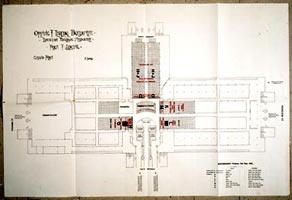
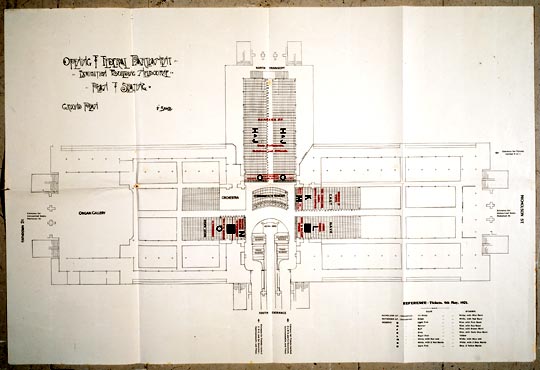 |
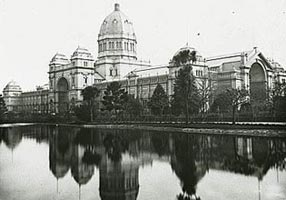 |
Plan of seating. Opening of Federal Parliament, Exhibition Building, Melbourne, 9 May 1901
National Library of Australia |
Exhibition Building, Melbourne
National Library of Australia |
|
Opening of the First Parliament of the Commonwealth of Australia, 9 May 1901
Senate Resource Centre
The first Commonwealth parliamentarians are shown assembled on a low platform before the Duke of York and the Governor-General, in the Melbourne Exhibition Building.
Prime Minister Edmund Barton stands centre front, flanked by members of the Ministry. Parliamentary clerks stand at each end. Behind, senators are to the left and members of the House of Representatives are to the right. |
The senators-elect assembled on a low platform in front of a dais in the Main Hall of the Exhibition Building at 11.30am. The Duke and the Governor-General, Lord Hopetoun, and their parties entered at 12 noon and ascended the dais. The elected members of the House of Representatives, waiting in the western nave, were then called by the Usher of the Black Rod, and took their places next to the senators.
The Clerk of the Parliaments read the Letters Patent of King Edward VII empowering the Duke to open the first Parliament of the Commonwealth of Australia. The Duke then addressed the parliamentarians, saying that his father was moved by the generous aid offered by the Australian colonies in the South African war, and in service in China, and expressing the King’s 'thankfulness and heartfelt satisfaction [at] the completion of that political union of which this Parliament is the embodiment.' The Duke declared the Parliament open; there was a fanfare of trumpets, and a cable message from the King was read out. The senators and members proceeded by foot or in carriages to Parliament House in nearby Spring Street, where each house met in order to elect a presiding officer.
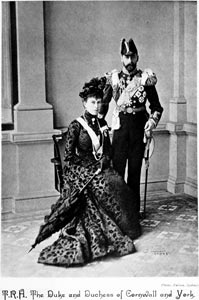
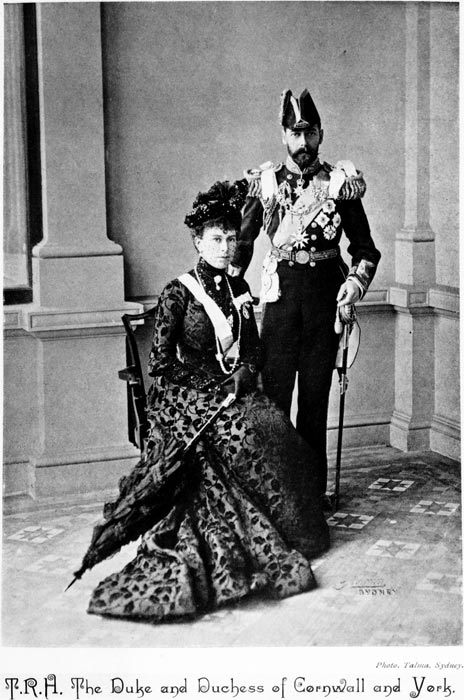 |
Their Royal Highnesses, the Duke and Duchess of Cornwall and York, May 1901
National Library of Australia
For the opening ceremony, the Duke wore the uniform of a Rear-Admiral in the Royal Navy and the green sash of the order of St Patrick across his chest. His wife, the Duchess of York, who wore a gown of black embossed velvet, and a string of diamonds from shoulder to waist, accompanied him.
She wore the white sash of the Order of Victoria and Albert and carried a black chiffon parasol.
The Duke and Duchess were to become King George V and Queen Mary of England and grandparents of the present Queen Elizabeth II.
|
|
The Opening of the First Parliament of the Commonwealth of Australia by HRH The Duke of Cornwall and York (later King George V), May 9 1901 (1903)
Tom Roberts (1856-1931), oil on canvas
Parliament House Art Collection, Department of Parliamentary Services, Canberra ACT
Tom Roberts' painting, known as 'The Big Picture', hangs in the foyer of the Main Committee Room at Parliament House, Canberra. It is on permanent loan to the Parliament of Australia from the British Royal Collection. |
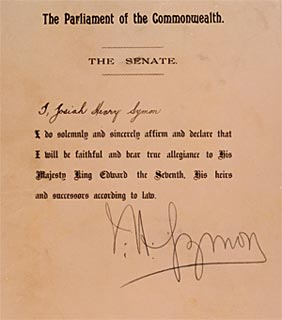 |
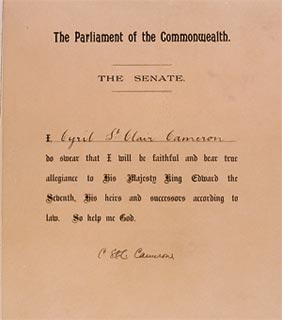
|
Affirmation signed by Senator Josiah Symon
Senate Table Office |
Oath signed by Senator Cyril St. Clair Cameron
Senate Table Office |
Lord Hopetoun administered an oath or affirmation of allegiance to each of the senators and members, while they remained in their places.
The oath and affirmations shown above, taken by members of the first parliament, as prescribed by the Constitution, are the same as those administered to current new parliamentarians. |
|


